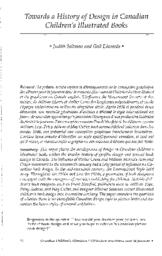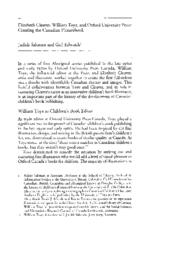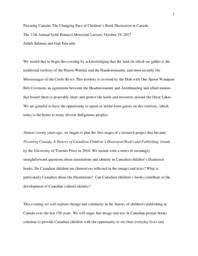Saltman, Judith
Person Preferred Name
Judith Saltman
Related Works
Content type
Digital Document
Abstract
This paper places the development of design in Canadian children's illustrated books within the broader history of graphic design and general book design in Canada. The influence of Walter Crane and William Morris's Arts and Crafts movement in the nineteenth century had a long period of influence on Canadian book design. In the mid-twentieth century, the International Style held sway. Throughout the 1950s and into the 1970s, a generation of book designers converged with the emergence of specialist publishing for children. Notable children's book designers such as Frank Newfeld, publishers such as William Toye, Patsy Aldana, and May Cutler, and designer Michael Solomon moved illustrated children's book design into innovative territory. The paper considers the question of whether there is an identifiable Canadian design style in picture books and examines the house styles of seminal publishers.
Origin Information
Content type
Digital Document
Abstract
In a series of four Aboriginal stories published in the late I960s and early 1970s by Oxford University Press Canada, William Toye, the influential editor at the Press, and Elizabeth Cleaver, artist and illustrator, worked together to create the first full-colour
picturebooks with identifiable Canadian themes and images. This fruitful collaboration between Toye and Cleaver, and its role in nurturing Cleaver's career as an innovative children's book illustrator, is an important part of the history of the development of Canadian children's book publishing.
Origin Information
Content type
Digital Document
Abstract
The chapter, "Publishing for children and students: Publishing for children" was written by the listed authors including Gail Edwards (Douglas College Faculty). The History of the Book in Canada is one of this country's great scholarly achievements, with three volumes spanning topics from Aboriginal communication systems established prior to European contact to the arrival of multinational publishing companies. Each volume observes developments in the realms of writing, publishing, dissemination, and reading, illustrating the process of a fledgling nation coming into its own. The third and final volume follows book history and print culture from the end of the First World War to 1980, discussing the influences on them of the twentieth century, including the country's growing demographic complexity and the rise of multiculturalism. Crucial to creating a sense of identity during this period was the Royal Commission on National Development in the Arts, Letters and Sciences, whose report of 1951 led to the establishment of influential cultural institutions such as the Canada Council for the Arts and the National Library of Canada. Other key developments included the initiation and growth of library systems, the expansion of film, radio, and television, the burgeoning of children's literature, enhanced opportunities for writers, the Quiet Revolution in Quebec, and the rise of Canadian studies and Canadian literature as respected fields for teaching and research. In English Canada, mainstream book publishing flourished during the 1920s, suffered severely during the Depression, went through a period of renewal and advance after the Second World War, but became imperilled by the 1970s. Small literary presses and allophone publishers, in turn, grew increasingly significant during the 1960s, a decade in which Quebec's new cultural policies began to foster ongoing support for francophone book culture. In addition to telling the stories of Canada's recent book history, this volume pays due attention to multifarious developments in print culture, including book prizes, sports writing, pulp magazines, the alternative press, Coles Notes, the international success of Harlequin, and the unprecedented influence of Les insolences du Frère Untel, the famous cry for education reform in 1960s Quebec. Volume three of the History of the Book in Canada marks the successful completion of an extraordinary project that documents the country's achievements for generations of scholars and readers to come.
Origin Information
Content type
Digital Document
Abstract
The chapter, "Children’s authors and their markets" was written by the listed authors including Gail Edwards (Douglas College Faculty). The History of the Book in Canada is one of this country's great scholarly achievements, with three volumes spanning topics from Aboriginal communication systems established prior to European contact to the arrival of multinational publishing companies. Each volume observes developments in the realms of writing, publishing, dissemination, and reading, illustrating the process of a fledgling nation coming into its own. The third and final volume follows book history and print culture from the end of the First World War to 1980, discussing the influences on them of the twentieth century, including the country's growing demographic complexity and the rise of multiculturalism.
Crucial to creating a sense of identity during this period was the Royal Commission on National Development in the Arts, Letters and Sciences, whose report of 1951 led to the establishment of influential cultural institutions such as the Canada Council for the Arts and the National Library of Canada. Other key developments included the initiation and growth of library systems, the expansion of film, radio, and television, the burgeoning of children's literature, enhanced opportunities for writers, the Quiet Revolution in Quebec, and the rise of Canadian studies and Canadian literature as respected fields for teaching and research. In English Canada, mainstream book publishing flourished during the 1920s, suffered severely during the Depression, went through a period of renewal and advance after the Second World War, but became imperilled by the 1970s. Small literary presses and allophone publishers, in turn, grew increasingly significant during the 1960s, a decade in which Quebec's new cultural policies began to foster ongoing support for francophone book culture.
In addition to telling the stories of Canada's recent book history, this volume pays due attention to multifarious developments in print culture, including book prizes, sports writing, pulp magazines, the alternative press, Coles Notes, the international success of Harlequin, and the unprecedented influence of Les insolences du Frère Untel, the famous cry for education reform in 1960s Quebec. Volume three of the History of the Book in Canada marks the successful completion of an extraordinary project that documents the country's achievements for generations of scholars and readers to come.
Origin Information
Content type
Digital Document
Abstract
Presented at the 11th annual Sybille Pantazzi Memorial Lecture, Toronto, Canada (October 17, 2017). In the lecture, “Picturing Canada: The Changing Face of Children’s Book Illustration in Canada,” Dr. Gail Edwards and Professor Judith Saltman explore change and continuity in the history of children’s publishing in Canada by looking at the picture books that the publishers have issued, and consider the challenges and rewards of publishing for children in a rapidly evolving global environment, focusing on the ways that image and text in Canadian picture books provide Canadian children with the opportunity to see their everyday lives and communities, and introduce them to ideas about region, about place, about history, about identity and belonging in a diverse, complex country. The first part of the lecture was based on research for Picturing Canada. Individual titles were located and present mini case studies in the evolution of the communications circuit of children's publishing in Canada over the last 150 years. The final section of the lecture was an informal dialogue about the transformation of the children's publishing industry in the last decade in response to changes in the retail book trade, new digital media, increasing globalization based on current individual and joint research.
Accompanying the lecture was a PowerPoint presentation that incorporated visual material from the book, Picturing Canada as well as book covers and illustrations from more recent publications. Due to copyright the PowerPoint presentation is not available. The book Picturing Canada is available in the Douglas Library collection.
Origin Information
Content type
Digital Document
Abstract
Beginnings to the 1890s : Canadian children's books in the imperial era -- The 1890s to the 1950s : 'and whether we are yet a nation' -- The postwar period : creating a children's publishing industry -- The 1970s : developing a children's publishing industry -- The 1980s : the flowering of Canadian children's illustrated books -- The 1990s to the present day : structural challenges and changes -- Children's illustrated books, 1990 to the present day -- Canadian cultural identity, Canadian cultural identities.
Origin Information





